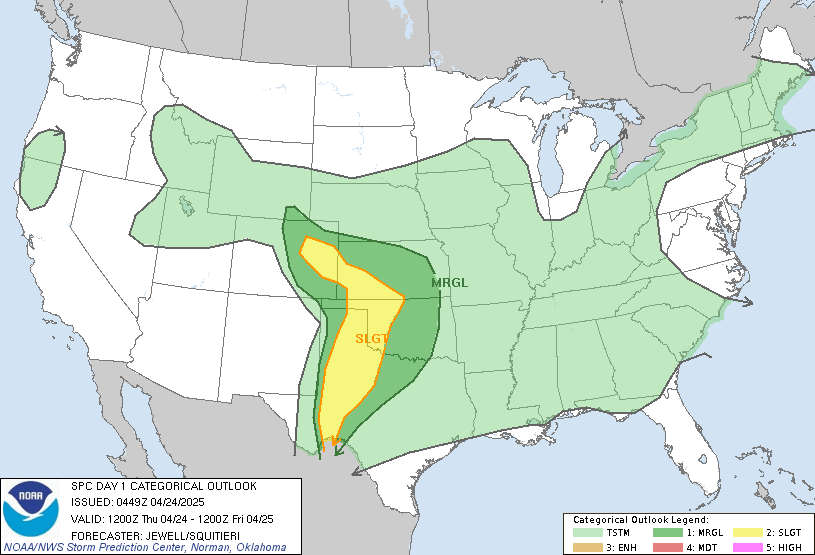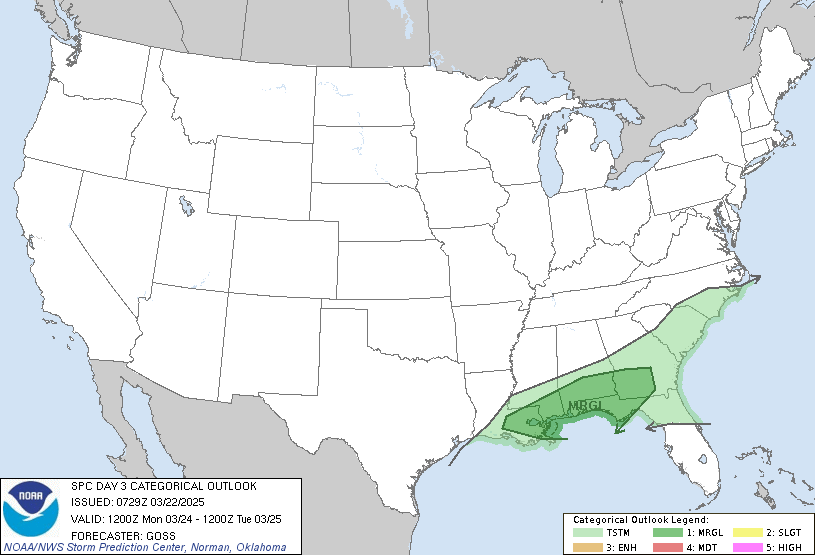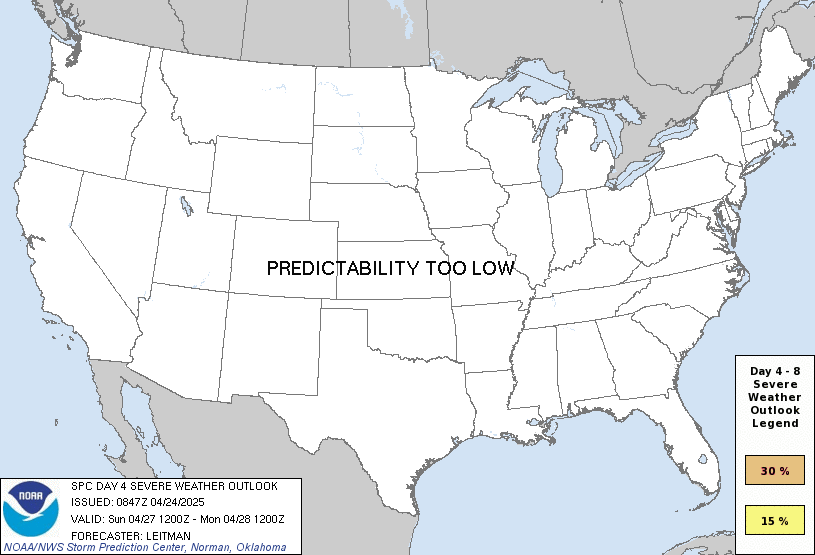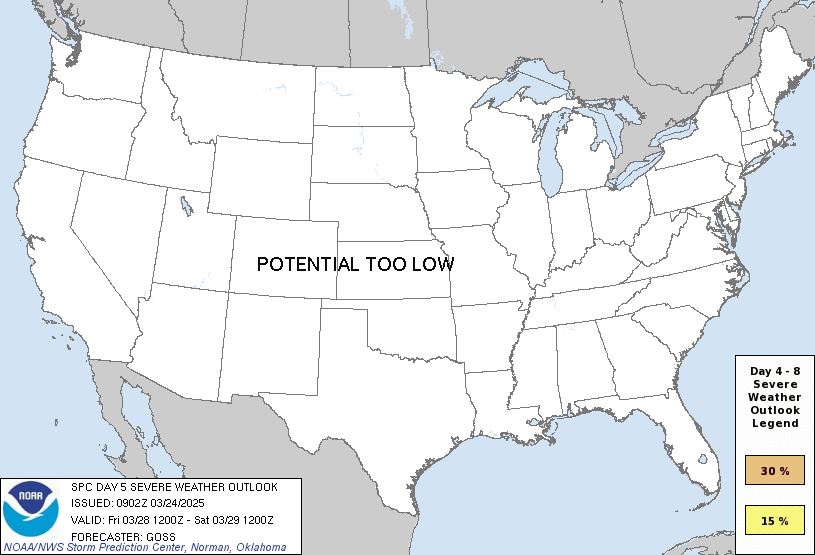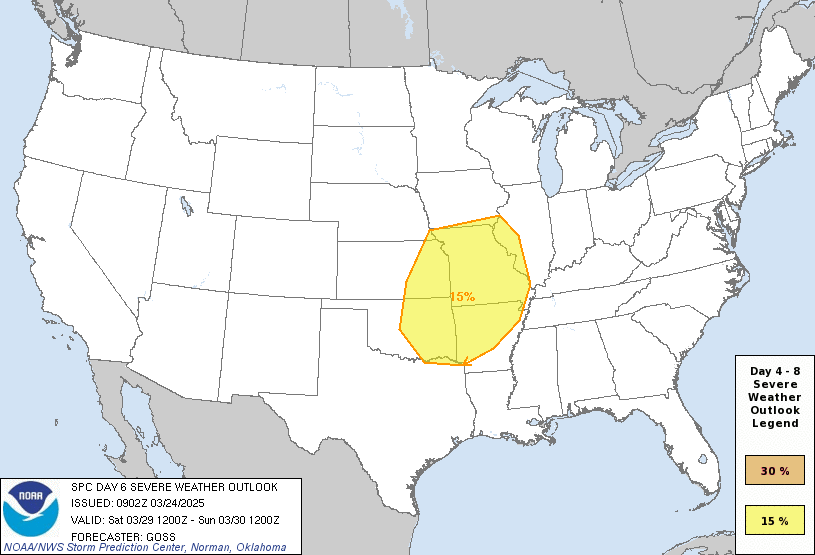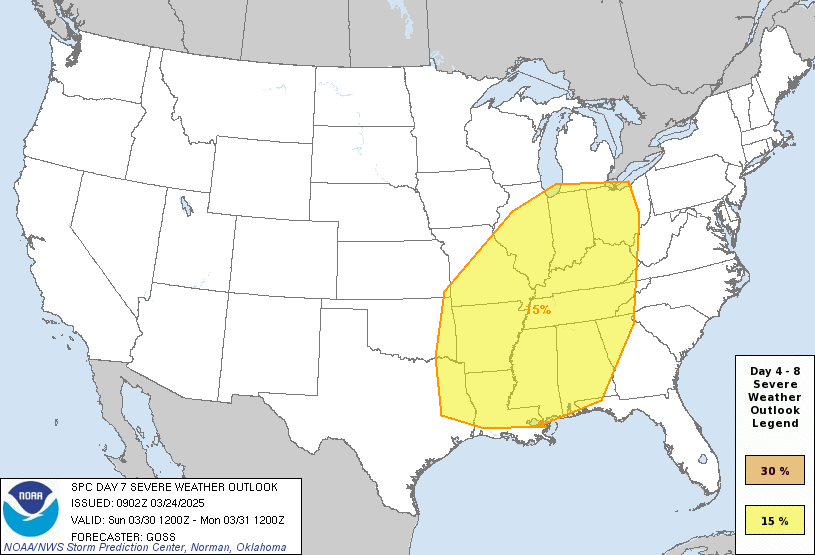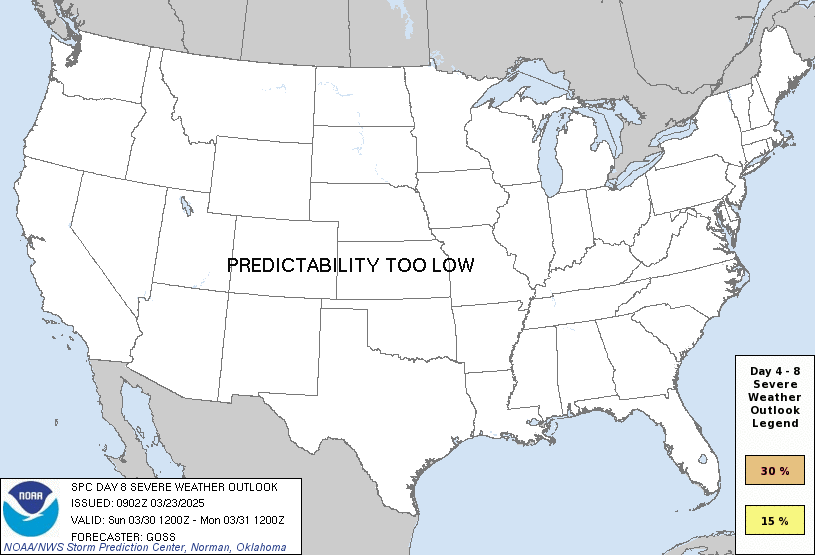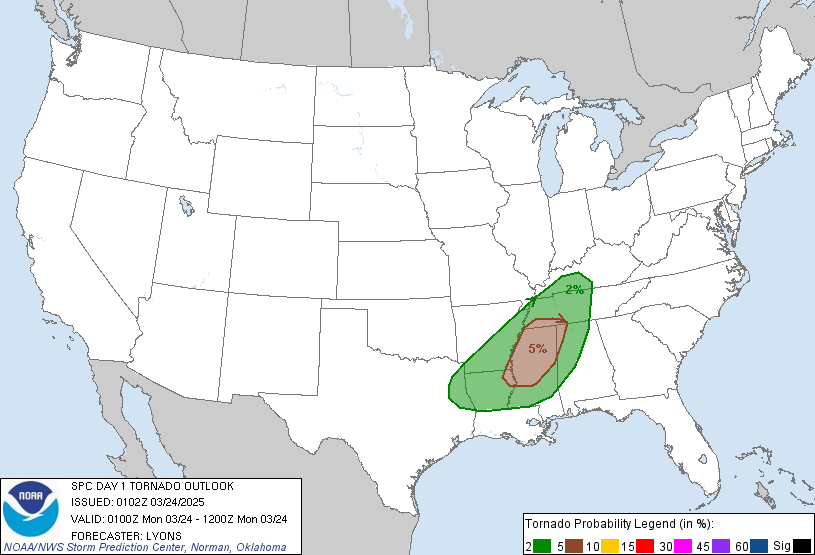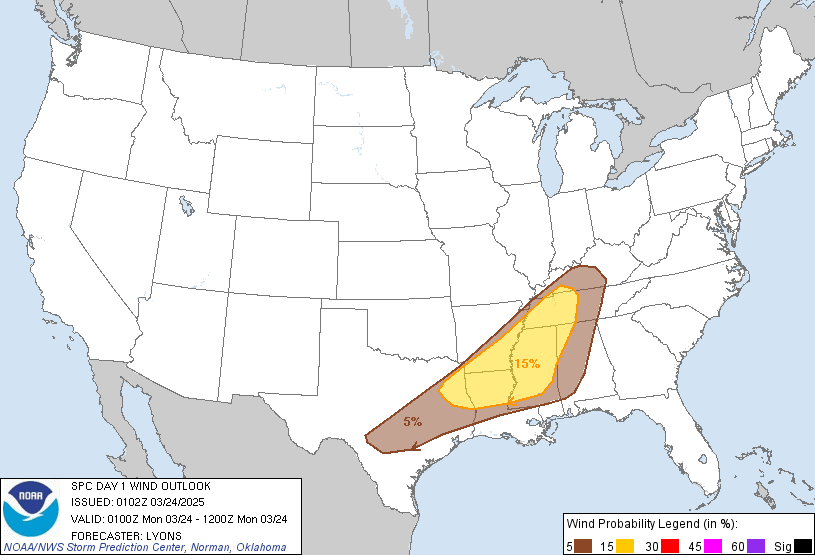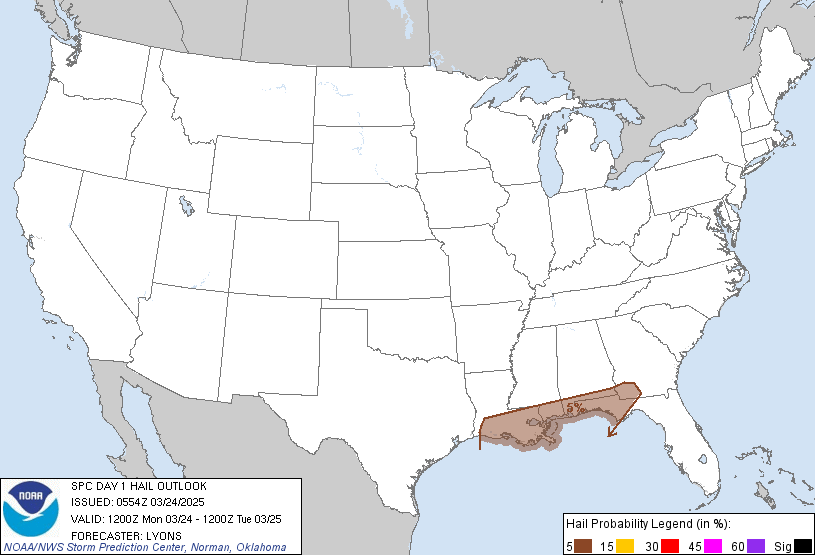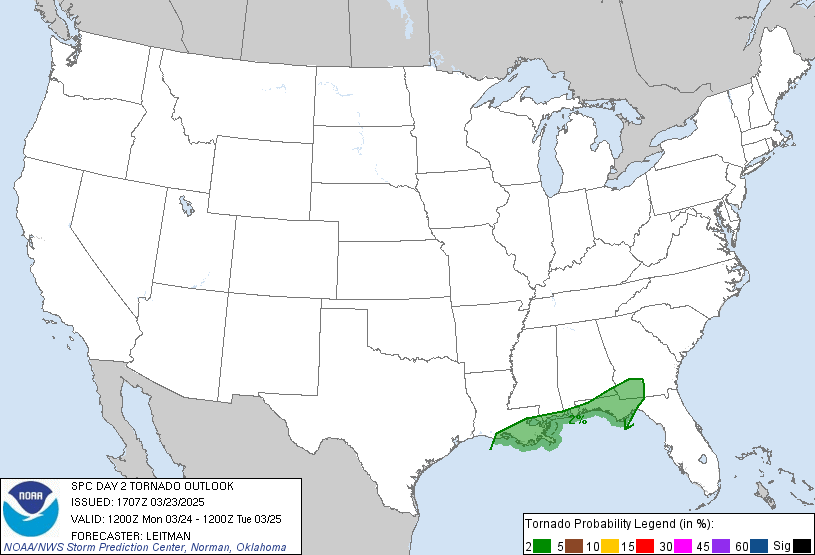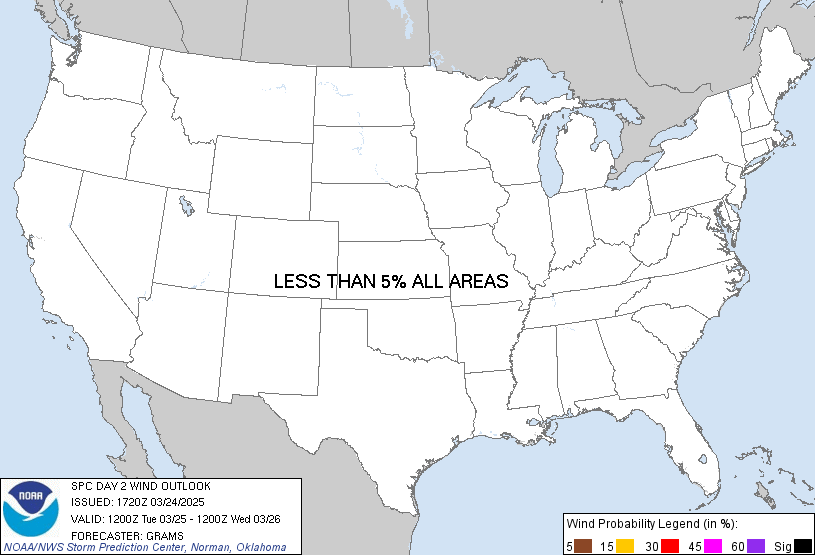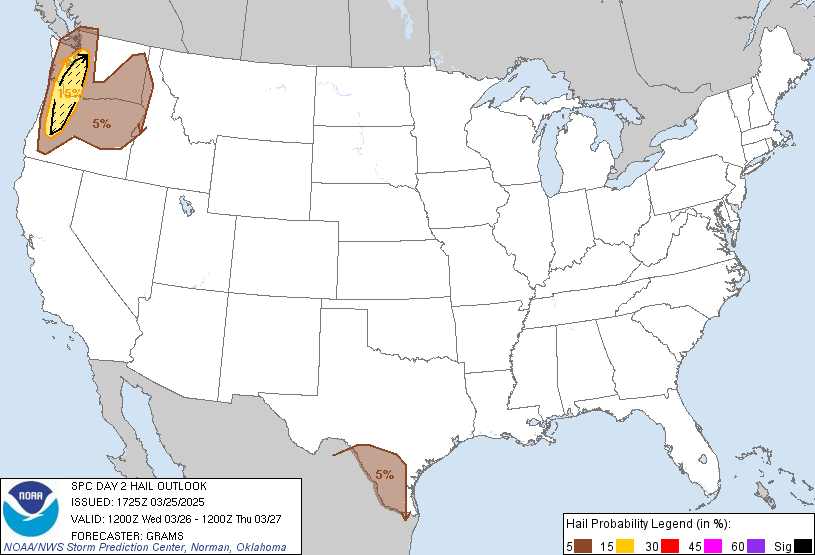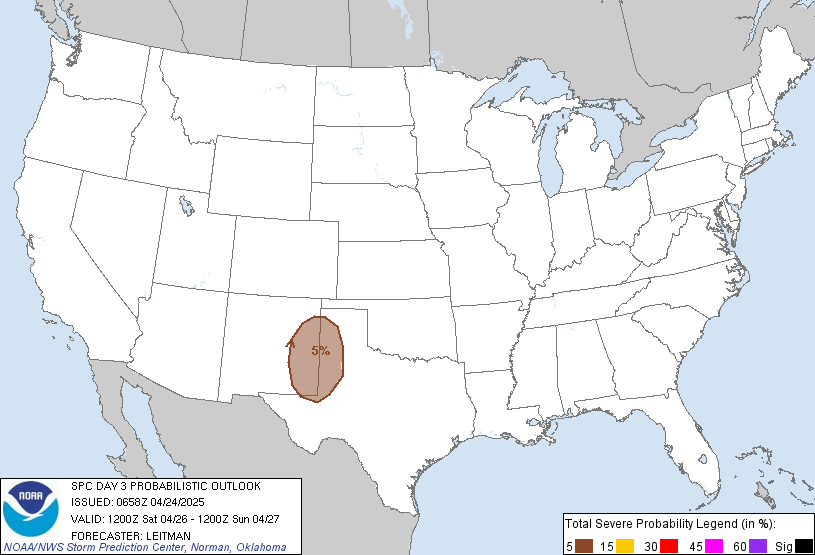Severe Weather Outlook
Hayley here - Do you like lofi music and terrifyingly loud computer voices? Then stop by the 24/7 ish severe weather live stream!
National Severe Weather Outlook for the next week
Here you'll find all available severe weather outlooks on one page.
Overview of the threat for the next few days
Outlook for Tuesday, July 1
Outlook Summary
Scattered severe thunderstorms should continue this evening over parts of the northern/central Plains, with large hail the primary risk. Isolated damaging winds will also remain possible for a couple more hours across portions of the Mid-Atlantic and Southeast.
Outlook Images
Detailed Outlook
← back to overviewSPC AC 020056
Day 1 Convective Outlook NWS Storm Prediction Center Norman OK 0756 PM CDT Tue Jul 01 2025
Valid 020100Z - 021200Z
THERE IS A SLIGHT RISK OF SEVERE THUNDERSTORMS ACROSS PARTS OF THE NORTHERN/CENTRAL PLAINS
### SUMMARY
Scattered severe thunderstorms should continue this evening over parts of the northern/central Plains, with large hail the primary risk. Isolated damaging winds will also remain possible for a couple more hours across portions of the Mid-Atlantic and Southeast.
Northern/Central Plains
Multiple supercells developed this afternoon/evening across parts of the northern/central High Plains, generally along/east of a surface lee trough. Although low-level flow remains fairly modest per area VWPs, sufficient west-northwesterly mid/upper-level flow will continue to foster around 30-40 kt of deep-layer shear and updraft organization. Persistent supercells will pose mainly a large hail threat as they move slowly south-southeastward for at least the next several hours. An increasing risk for isolated severe winds may also develop given the well-mixed boundary layer and gradual upscale growth anticipated. Reference Mesoscale Discussion 1538 for more details on the short-term severe threat across this region. A separate area of mainly elevated convection may develop later tonight across a broader portion of SD in a low-level warm advection regime. This activity may have an isolated hail threat.
Mid-Atlantic into the Southeast
Loosely organized convection should continue this evening from parts of the Mid-Atlantic and Southeast along/ahead of a cold front. An isolated threat for damaging winds should persist where pockets of moderate instability remain. But, generally modest deep-layer shear and a gradually stabilizing boundary layer with the loss of daytime heating will likely lead to a gradual reduction in the overall severe threat this evening.
..Gleason.. 07/02/2025
CLICK TO GET WUUS01 PTSDY1 PRODUCT
NOTE: THE NEXT DAY 1 OUTLOOK IS SCHEDULED BY 0600Z
Outlook for Wednesday, July 2
Outlook Summary
At least scattered storms are possible across a large portion of the continental U.S. on Wednesday. Isolated severe gusts may accompany the stronger storms over portions of the Northern Rockies and the Upper Midwest to central Michigan region.
Outlook Images
Detailed Outlook
← back to overviewSPC AC 011728
Day 2 Convective Outlook NWS Storm Prediction Center Norman OK 1228 PM CDT Tue Jul 01 2025
Valid 021200Z - 031200Z
THERE IS A MARGINAL RISK OF SEVERE THUNDERSTORMS ACROSS PORTIONS OF THE NORTHERN ROCKIES AND UPPER MIDWEST INTO THE GREAT LAKES
### SUMMARY
At least scattered storms are possible across a large portion of the continental U.S. on Wednesday. Isolated severe gusts may accompany the stronger storms over portions of the Northern Rockies and the Upper Midwest to central Michigan region.
Synopsis
A mid-level trough will amplify while tracking toward New England, with an upper ridge poised to build over the central U.S. as another mid-level trough impinges on the Pacific Northwest tomorrow (Wednesday). Widespread, rich low-level moisture will encourage at least scattered thunderstorm development across much of the CONUS. However, the best chance for strong to isolated severe thunderstorms will be over parts of the Northern Rockies and the Upper Midwest/Great Lakes regions. Here, low-level moisture and instability will best overlap with modest mid-level westerly flow along the periphery of the upper ridge, where some vertical wind shear will be present to encourage storm organization.
Portions of the Northern Rockies
Through the day, surface heating will support mixing of a dry boundary layer, which may deepen to 500 mb in spots. Tropospheric lapse rates will steepen to around 9 C/km, boosting SBCAPE into the 500-1500 J/kg range. High-based thunderstorms should develop by afternoon peak heating. Modest mid-level flow along the periphery of the ridge will overspread the dry boundary layer, resulting in elongated, straight hodographs and 30 kts of effective bulk shear. Multicell structures or perhaps a transient supercell will be the likely storm modes. Given the dry boundary layer, the stronger storm cores may produce a few severe gusts.
Upper Midwest into the Great Lakes
Along the eastern periphery of the upper ridge, broad northwesterly mid/upper flow will overspread the Upper Midwest and Great Lakes region during the afternoon. Modest low-level moisture and mid-level lapse rates will contribute to 1000-2000 J/kg MLCAPE by afternoon peak heating. A belt of stronger northwesterly 500 mb flow will overspread the Great Lakes as the eastern trough deepens in the 18-00Z time frame, contributing to vertical speed shear and elongated, straight hodographs. Over 30 kts of unidirectional effective bulk shear will support multicells capable of producing a few instances of severe wind and/or hail.
..Squitieri.. 07/01/2025
CLICK TO GET WUUS02 PTSDY2 PRODUCT
NOTE: THE NEXT DAY 2 OUTLOOK IS SCHEDULED BY 0600Z
Outlook for Thursday, July 3
Outlook Summary
Scattered storms capable of large hail and severe wind gusts are forecast across the Northeast on Thursday. Isolated severe wind gusts are also possible in the Northern Plains and parts of the Upper Midwest into the Great Lakes.
Outlook Images
Detailed Outlook
← back to overviewSPC AC 011934
Day 3 Convective Outlook NWS Storm Prediction Center Norman OK 0234 PM CDT Tue Jul 01 2025
Valid 031200Z - 041200Z
THERE IS A MARGINAL RISK OF SEVERE THUNDERSTORMS FOR PARTS OF THE NORTHERN HIGH PLAINS…UPPER MIDWEST INTO THE GREAT LAKES…AND THE NORTHEAST
### SUMMARY
Scattered storms capable of large hail and severe wind gusts are forecast across the Northeast on Thursday. Isolated severe wind gusts are also possible in the Northern Plains and parts of the Upper Midwest into the Great Lakes.
Synopsis
A mid-level trough will deepen over New England as an upper trough moves over the Midwest, and broad mid-level troughing with multiple embedded impulses, overspreads the U.S. west of the Rockies on Thursday. The East and West Coast upper troughs will encourage surface troughing across the Northeast and the Plains states, as well as weak surface low development over the Great Basin. Given the presence of seasonal low-level moisture, and expected diurnal heating, at least scattered thunderstorms will develop across much of the Interior West, into the Plains, Midwest, and East Coast regions. At least isolated strong to potentially severe storms could develop over parts of the northern CONUS, where appreciable vertical wind shear will overspread the warm, moist airmass to support organized thunderstorms.
Northeast
As the surface trough progresses across the Northeast, deep-layer northwesterly flow will overspread the region. Diurnal heating of a seasonably moist boundary layer will foster modest buoyancy, with 500-1500 J/kg MLCAPE expected. As thunderstorms develop during the afternoon, they will encounter roughly 25-35 kts of effective bulk shear, characterized by elongated/straight hodographs. Multicells and short line segments should be the main storm modes, with isolated damaging gusts the primary threat with the stronger storms.
### Upper Midwest into the Great Lakes
A belt of 35-45 kt northwesterly flow on the back side of the East Coast upper trough will overspread the Great Lakes during the afternoon hours, where diurnal heating of a moist low-level airmass will destabilize the boundary layer. MLCAPE may exceed 2000 J/kg in spots (locally higher to 3000 J/kg toward southeast MN given 7.5+ C/km mid-level lapse rates farther to the west). Forecast soundings depict modestly curved and elongated hodographs, supporting multicells and perhaps supercells with some of the stronger storms. Isolated severe wind and hail may accompany the stronger storms. Greater severe probabilities may be needed in future outlooks if favorable trends in greater storm coverage are realized in later available guidance.
Northern High Plains… A mid-level impulse will traverse the broader western upper troughing regime and eject into the northern High Plains Thursday afternoon. By this time, steep mid-level lapse rates will overspread upper 60s F dewpoints to promote moderate to locally strong instability, with MLCAPE exceeding 3000 J/kg. Modest turning and strengthening of the winds with height will support elongated hodographs with slight low-level curvature, which will support multicells and splitting supercells given the aforementioned buoyancy. The storms are forecast to be isolated in coverage, with a few instances of severe wind and hail expected.
..Squitieri.. 07/01/2025
CLICK TO GET WUUS03 PTSDY3 PRODUCT
NOTE: THE NEXT DAY 3 OUTLOOK IS SCHEDULED BY 0730Z
Outlook for Friday, July 4
Outlook Images
Note on Medium Range Outlooks
You are looking at an outlook that is part of the medium range forecast (the outlook for days 4-8). The most important thing to note is that lack of a risk does not mean zero risk. Generally speaking, confidence has to be pretty high for the Storm Prediction Center to have an outlook area this far into the future.
When no specific risk areas are shown, you might see one of these phrases:
- Predictability Too Low: This means that severe storms might be possible, but forecasters aren't confident enough about where or when they might occur. Think of it as the models showing different possibilities, like pieces of a puzzle that haven't come together yet.
- Potential Too Low: This means forecasters are fairly confident that widespread severe weather is NOT expected on that day. While isolated storms might still occur, the chance of reaching severe criteria across any given area is very low.
If you bookmark this page, it will continue to update with each new outlook that is issued.
Days Covered in this Outlook
| Day 4 | Friday, July 4 | predictability too low |
| Day 5 | Saturday, July 5 | predictability too low |
| Day 6 | Sunday, July 6 | predictability too low |
| Day 7 | Monday, July 7 | predictability too low |
| Day 8 | Tuesday, July 8 | predictability too low |
Detailed Outlook
← back to overviewZCZC SPCSWOD48 ALL ACUS48 KWNS 010900 SPC AC 010900
Day 4-8 Convective Outlook NWS Storm Prediction Center Norman OK 0400 AM CDT Tue Jul 01 2025
Valid 041200Z - 091200Z
DISCUSSION
A mid-level trough will traverse the Northern Plains and Upper Midwest on Friday. This will likely be the most substantial severe weather threat during the extended period before broad, strong ridging builds across much of the eastern/central CONUS.
Day 4/Friday
As a positively tilted mid-level trough traverses the northern Plains on Friday, strong southerly flow will advect moisture northward across a broad warm sector near the Upper Midwest. This will result in moderate to strong instability as temperatures warm well into the 80s. Widespread thunderstorms are likely along the frontal zone during the afternoon/evening. 35 to 40 knots of mid-level flow will overspread the warm sector which will provide some shear for storm organization. However, southwesterly surface winds will also increase during the afternoon within the warm front and therefore, the net shear may remain somewhat minimal. Some organized storms with a threat for large hail and severe wind gusts are possible, but the aforementioned concerns about deep-layer shear preclude the confidence needed for 15% severe weather probabilities at this time.
Beyond Day 4, moderate to strong instability is forecast across much of the central and eastern CONUS with widespread thunderstorm activity likely. However, shear will remain mostly nebulous with the stronger mid-level flow confined to areas north of the better instability. Therefore, some marginal regional severe weather threat will be likely most days, but a more organized severe weather risk appears unlikely at this time.
..Bentley.. 07/01/2025
CLICK TO GET WUUS48 PTSD48 PRODUCT
Outlook for Saturday, July 5
Outlook Images
Note on Medium Range Outlooks
You are looking at an outlook that is part of the medium range forecast (the outlook for days 4-8). The most important thing to note is that lack of a risk does not mean zero risk. Generally speaking, confidence has to be pretty high for the Storm Prediction Center to have an outlook area this far into the future.
When no specific risk areas are shown, you might see one of these phrases:
- Predictability Too Low: This means that severe storms might be possible, but forecasters aren't confident enough about where or when they might occur. Think of it as the models showing different possibilities, like pieces of a puzzle that haven't come together yet.
- Potential Too Low: This means forecasters are fairly confident that widespread severe weather is NOT expected on that day. While isolated storms might still occur, the chance of reaching severe criteria across any given area is very low.
If you bookmark this page, it will continue to update with each new outlook that is issued.
Days Covered in this Outlook
| Day 4 | Friday, July 4 | predictability too low |
| Day 5 | Saturday, July 5 | predictability too low |
| Day 6 | Sunday, July 6 | predictability too low |
| Day 7 | Monday, July 7 | predictability too low |
| Day 8 | Tuesday, July 8 | predictability too low |
Detailed Outlook
← back to overviewZCZC SPCSWOD48 ALL ACUS48 KWNS 010900 SPC AC 010900
Day 4-8 Convective Outlook NWS Storm Prediction Center Norman OK 0400 AM CDT Tue Jul 01 2025
Valid 041200Z - 091200Z
DISCUSSION
A mid-level trough will traverse the Northern Plains and Upper Midwest on Friday. This will likely be the most substantial severe weather threat during the extended period before broad, strong ridging builds across much of the eastern/central CONUS.
Day 4/Friday
As a positively tilted mid-level trough traverses the northern Plains on Friday, strong southerly flow will advect moisture northward across a broad warm sector near the Upper Midwest. This will result in moderate to strong instability as temperatures warm well into the 80s. Widespread thunderstorms are likely along the frontal zone during the afternoon/evening. 35 to 40 knots of mid-level flow will overspread the warm sector which will provide some shear for storm organization. However, southwesterly surface winds will also increase during the afternoon within the warm front and therefore, the net shear may remain somewhat minimal. Some organized storms with a threat for large hail and severe wind gusts are possible, but the aforementioned concerns about deep-layer shear preclude the confidence needed for 15% severe weather probabilities at this time.
Beyond Day 4, moderate to strong instability is forecast across much of the central and eastern CONUS with widespread thunderstorm activity likely. However, shear will remain mostly nebulous with the stronger mid-level flow confined to areas north of the better instability. Therefore, some marginal regional severe weather threat will be likely most days, but a more organized severe weather risk appears unlikely at this time.
..Bentley.. 07/01/2025
CLICK TO GET WUUS48 PTSD48 PRODUCT
Outlook for Sunday, July 6
Outlook Images
Note on Medium Range Outlooks
You are looking at an outlook that is part of the medium range forecast (the outlook for days 4-8). The most important thing to note is that lack of a risk does not mean zero risk. Generally speaking, confidence has to be pretty high for the Storm Prediction Center to have an outlook area this far into the future.
When no specific risk areas are shown, you might see one of these phrases:
- Predictability Too Low: This means that severe storms might be possible, but forecasters aren't confident enough about where or when they might occur. Think of it as the models showing different possibilities, like pieces of a puzzle that haven't come together yet.
- Potential Too Low: This means forecasters are fairly confident that widespread severe weather is NOT expected on that day. While isolated storms might still occur, the chance of reaching severe criteria across any given area is very low.
If you bookmark this page, it will continue to update with each new outlook that is issued.
Days Covered in this Outlook
| Day 4 | Friday, July 4 | predictability too low |
| Day 5 | Saturday, July 5 | predictability too low |
| Day 6 | Sunday, July 6 | predictability too low |
| Day 7 | Monday, July 7 | predictability too low |
| Day 8 | Tuesday, July 8 | predictability too low |
Detailed Outlook
← back to overviewZCZC SPCSWOD48 ALL ACUS48 KWNS 010900 SPC AC 010900
Day 4-8 Convective Outlook NWS Storm Prediction Center Norman OK 0400 AM CDT Tue Jul 01 2025
Valid 041200Z - 091200Z
DISCUSSION
A mid-level trough will traverse the Northern Plains and Upper Midwest on Friday. This will likely be the most substantial severe weather threat during the extended period before broad, strong ridging builds across much of the eastern/central CONUS.
Day 4/Friday
As a positively tilted mid-level trough traverses the northern Plains on Friday, strong southerly flow will advect moisture northward across a broad warm sector near the Upper Midwest. This will result in moderate to strong instability as temperatures warm well into the 80s. Widespread thunderstorms are likely along the frontal zone during the afternoon/evening. 35 to 40 knots of mid-level flow will overspread the warm sector which will provide some shear for storm organization. However, southwesterly surface winds will also increase during the afternoon within the warm front and therefore, the net shear may remain somewhat minimal. Some organized storms with a threat for large hail and severe wind gusts are possible, but the aforementioned concerns about deep-layer shear preclude the confidence needed for 15% severe weather probabilities at this time.
Beyond Day 4, moderate to strong instability is forecast across much of the central and eastern CONUS with widespread thunderstorm activity likely. However, shear will remain mostly nebulous with the stronger mid-level flow confined to areas north of the better instability. Therefore, some marginal regional severe weather threat will be likely most days, but a more organized severe weather risk appears unlikely at this time.
..Bentley.. 07/01/2025
CLICK TO GET WUUS48 PTSD48 PRODUCT
Outlook for Monday, July 7
Outlook Images
Note on Medium Range Outlooks
You are looking at an outlook that is part of the medium range forecast (the outlook for days 4-8). The most important thing to note is that lack of a risk does not mean zero risk. Generally speaking, confidence has to be pretty high for the Storm Prediction Center to have an outlook area this far into the future.
When no specific risk areas are shown, you might see one of these phrases:
- Predictability Too Low: This means that severe storms might be possible, but forecasters aren't confident enough about where or when they might occur. Think of it as the models showing different possibilities, like pieces of a puzzle that haven't come together yet.
- Potential Too Low: This means forecasters are fairly confident that widespread severe weather is NOT expected on that day. While isolated storms might still occur, the chance of reaching severe criteria across any given area is very low.
If you bookmark this page, it will continue to update with each new outlook that is issued.
Days Covered in this Outlook
| Day 4 | Friday, July 4 | predictability too low |
| Day 5 | Saturday, July 5 | predictability too low |
| Day 6 | Sunday, July 6 | predictability too low |
| Day 7 | Monday, July 7 | predictability too low |
| Day 8 | Tuesday, July 8 | predictability too low |
Detailed Outlook
← back to overviewZCZC SPCSWOD48 ALL ACUS48 KWNS 010900 SPC AC 010900
Day 4-8 Convective Outlook NWS Storm Prediction Center Norman OK 0400 AM CDT Tue Jul 01 2025
Valid 041200Z - 091200Z
DISCUSSION
A mid-level trough will traverse the Northern Plains and Upper Midwest on Friday. This will likely be the most substantial severe weather threat during the extended period before broad, strong ridging builds across much of the eastern/central CONUS.
Day 4/Friday
As a positively tilted mid-level trough traverses the northern Plains on Friday, strong southerly flow will advect moisture northward across a broad warm sector near the Upper Midwest. This will result in moderate to strong instability as temperatures warm well into the 80s. Widespread thunderstorms are likely along the frontal zone during the afternoon/evening. 35 to 40 knots of mid-level flow will overspread the warm sector which will provide some shear for storm organization. However, southwesterly surface winds will also increase during the afternoon within the warm front and therefore, the net shear may remain somewhat minimal. Some organized storms with a threat for large hail and severe wind gusts are possible, but the aforementioned concerns about deep-layer shear preclude the confidence needed for 15% severe weather probabilities at this time.
Beyond Day 4, moderate to strong instability is forecast across much of the central and eastern CONUS with widespread thunderstorm activity likely. However, shear will remain mostly nebulous with the stronger mid-level flow confined to areas north of the better instability. Therefore, some marginal regional severe weather threat will be likely most days, but a more organized severe weather risk appears unlikely at this time.
..Bentley.. 07/01/2025
CLICK TO GET WUUS48 PTSD48 PRODUCT
Outlook for Tuesday, July 8
Outlook Images
Note on Medium Range Outlooks
You are looking at an outlook that is part of the medium range forecast (the outlook for days 4-8). The most important thing to note is that lack of a risk does not mean zero risk. Generally speaking, confidence has to be pretty high for the Storm Prediction Center to have an outlook area this far into the future.
When no specific risk areas are shown, you might see one of these phrases:
- Predictability Too Low: This means that severe storms might be possible, but forecasters aren't confident enough about where or when they might occur. Think of it as the models showing different possibilities, like pieces of a puzzle that haven't come together yet.
- Potential Too Low: This means forecasters are fairly confident that widespread severe weather is NOT expected on that day. While isolated storms might still occur, the chance of reaching severe criteria across any given area is very low.
If you bookmark this page, it will continue to update with each new outlook that is issued.
Days Covered in this Outlook
| Day 4 | Friday, July 4 | predictability too low |
| Day 5 | Saturday, July 5 | predictability too low |
| Day 6 | Sunday, July 6 | predictability too low |
| Day 7 | Monday, July 7 | predictability too low |
| Day 8 | Tuesday, July 8 | predictability too low |
Detailed Outlook
← back to overviewZCZC SPCSWOD48 ALL ACUS48 KWNS 010900 SPC AC 010900
Day 4-8 Convective Outlook NWS Storm Prediction Center Norman OK 0400 AM CDT Tue Jul 01 2025
Valid 041200Z - 091200Z
DISCUSSION
A mid-level trough will traverse the Northern Plains and Upper Midwest on Friday. This will likely be the most substantial severe weather threat during the extended period before broad, strong ridging builds across much of the eastern/central CONUS.
Day 4/Friday
As a positively tilted mid-level trough traverses the northern Plains on Friday, strong southerly flow will advect moisture northward across a broad warm sector near the Upper Midwest. This will result in moderate to strong instability as temperatures warm well into the 80s. Widespread thunderstorms are likely along the frontal zone during the afternoon/evening. 35 to 40 knots of mid-level flow will overspread the warm sector which will provide some shear for storm organization. However, southwesterly surface winds will also increase during the afternoon within the warm front and therefore, the net shear may remain somewhat minimal. Some organized storms with a threat for large hail and severe wind gusts are possible, but the aforementioned concerns about deep-layer shear preclude the confidence needed for 15% severe weather probabilities at this time.
Beyond Day 4, moderate to strong instability is forecast across much of the central and eastern CONUS with widespread thunderstorm activity likely. However, shear will remain mostly nebulous with the stronger mid-level flow confined to areas north of the better instability. Therefore, some marginal regional severe weather threat will be likely most days, but a more organized severe weather risk appears unlikely at this time.
..Bentley.. 07/01/2025
CLICK TO GET WUUS48 PTSD48 PRODUCT
National Risk Overview
- Tuesday, July 1
- TORNADO: low
- HAIL: 15%
- WIND: 5%
- Wednesday, July 2
- TORNADO: low
- HAIL: 5%
- WIND: 5%
- Thursday, July 3
- ANY SEVERE: 5%
- Friday, July 4
- ANY SEVERE: predictability too low
- Saturday, July 5
- ANY SEVERE: predictability too low
- Sunday, July 6
- ANY SEVERE: predictability too low
- Monday, July 7
- ANY SEVERE: predictability too low
- Tuesday, July 8
- ANY SEVERE: predictability too low
Your Severe Outlook
Hey, it looks like your location wasn't detected.
Drag the marker on the map and we'll show you the severe weather potential for a given location.
Hi, I'm Hayley. Did you know that I run this site out of my own pocket? So if you'd like to help out and you're already planning on buying something off of Amazon, why not use our Amazon Severe Weather Outlook link before you buy and we'll get a tiny portion of your purchase.
About Severe Weather Outlook . com
SWO started as a spinoff project of wickedwx, but has since replaced the site.
- tornado hq - live severe weather warnings
- cyclocane - hurricanes/typhoons/cyclones
- tornado solitaire - play cards while you monitor the US severe weather threat
- tertremo - live view of earthquakes around the world
- earthquake solitaire - get live earthquake updates as you play your favorite card game


